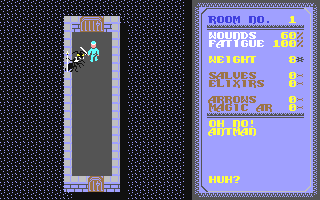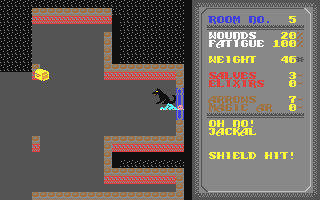|
In
the earliest days of home computers, role playing games
had just begun to achieve relative mass appeal. Advanced
Dungeons and Dragons had been on the market for
only a short while and had become instantly successful.
It was at this time that the then young Epyx brought
out The Temple of Apshai, intending it to be
real role playing on a home micro.
The
success of the first title led to the rest of the Apshai
Trilogy which included Upper Reaches of Apshai and
the Curse of Ra. All the titles were expensive,
totalling nearly a hundred pounds together. They were
primitive as well. 16K ROM cartridges were used for
the originals and little was understood about the capabilities
of the micros for which they were produced.
Now,
some years later, Epyx have updated the appearance and
capabilities of all three programs and repackaged them
as the Apshai Trilogy. What's more, they're all
on one diskette at less than a third of their original
high price! But for those of you who missed them first
time around, here's a run down on what all the fuss
is about.
What
you gel for your pennies is a disk (which may be used
for saved games), an instruction booklet detailing the
world of Apshai as well as the game itself and a summary
card to speed up play. The disk utilises a turbo load
technique and therefore presents you with a title screen
and tune faster than you may expect. Leading on from
this screen is the Innkeeper's screen which heralds
game setup. It's a kind of tradition that all the best
role playing games begin in a tavern or bar (perhaps
it reflects upon the kind of people who play the games
themselves). On this screen a saved character for the
game may be called from disk, a randomly generated character
selected, or your own character may be created.

There
are six major characteristics: Strength, Constitution,
Dexterity, Intelligence, Intuition and Ego. As in the
more popular role playing games, the characteristics
are generated on a 3D6 (three, six-sided dice)
probability curve. The lowest characteristic is 3 and
the highest 18, averaging out at 10-11. The values of
these attributes affect the abilities of the character.
All
characters (except those created by the player) begin
with 120 silver pieces to spend on weapons and equipment
from the innkeeper. Unless haggling tactics are used,
the character will be taken for everything he has, so
be careful. The variety of weapons, armour and miscellaneous
items available for purchase from the innkeeper is great,
so characters may be kitted out individually. Weapons
and armour may be magical, but such items are only available
through adventuring. If they are, there will be bonuses
to a character's actions in combat.
After
the character is equipped, the option to enter the dungeon
is presented. Any of the three Realms that make
up the trilogy may be selected followed by the Level,
1-4, in terms of difficulty. Once the dungeon has been
entered, your character is displayed surrounded by the
area of the dungeon within his field of vision. To the
right of this display is a status screen showing the
fitness of the character, weapon, inventory and message
window.
To
move the character, the 1-9 keys are pressed to indicate
how many steps are taken that turn. The more steps,
the faster the character is moving and consequently,
the sooner he will become exhausted. To change facing,
the L and R keys turn 'you' 90 degrees left or right,
or the V key produces a 'volte-face' 180 degree turn.
When the character moves, the screen scrolls and reveals
new areas of the dungeon in doing so. In this fashion,
the entire dungeon complex may be explored. To enter
rooms, pick up treasure for search or hidden doors,
special one-key commands may be referenced from the
Command Card and implemented as required.

Eventually,
your character will encounter one of the many creatures
inhabiting the dungeons. It is possible to run away,
but as such is not the stuff of adventuring, combat
is likely to ensue. Attacking the creature with a melee
weapon requires no fast joystick handling as the whole
thing is moderated by the use of turns. The Attack command
allows a simple jab at the enemy, while Thrust is an
all out hack. This increases your chances of hitting
the creature and of delivering a mortal blow, but the
creature's chances of successfully causing a wound are
also increased. Arrows (both magic and normal) may be
used as ranged weapons and usually kill anything they
hit. But of course, you only have a limited supply of
these.
Combat
need not necessarily be the inevitable course of action
when a creature is encountered. It is sometimes possible
to parley with them, using the commands available. If
combat is commenced against every creature you encounter,
it is still possible to do well in the game but you
may well miss out on some treasure. Where to fight and
where to parley is only learned with practice.
As
in a conventional role playing game, successful combats
and treasure hunting earns the character experience
points. These reflect the increase in the character's
skills. An increase in experience helps in the higher
dungeon levels. Monsters are fought more easily and
efficiently. Experience points are otherwise similar
to conventional scoring methods.
At
various points in the game, you may find your way back
to the entrance point to a dungeon level and return
to the inn from there. This is the point where games
and characters may be saved. On the game disk, there
is room for up to one game and fifty characters. It
would take many hours continual play to complete the
game in a single session, so both of these options should
be used from time to time.
After
teaching you how to play, the manual is far from redundant.
It describes the different creatures you are likely
to meet in the Apshai dungeons, hints on play and, perhaps
most useful, provides text descriptions of various locations
and treasure details. It is intended to be a valuable
aid throughout play and any adventurer will find that
the information it provides is far from irrelevant.
If you are to successfully explore the entire dungeon
network, you have to build up wealth, knowledge and
experience. And that is going to mean a lot of games.
The
game brings back memories of my first role playing experiences.
Although for a computer game the system is highly complex
in terms of authenticity, the game still relies
on monster hacking
|